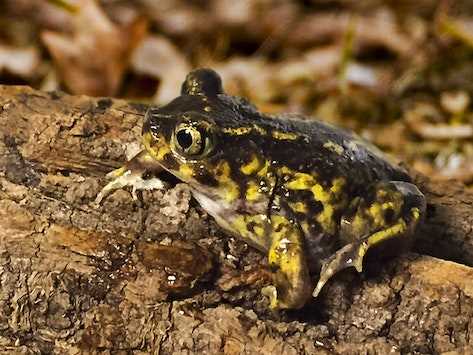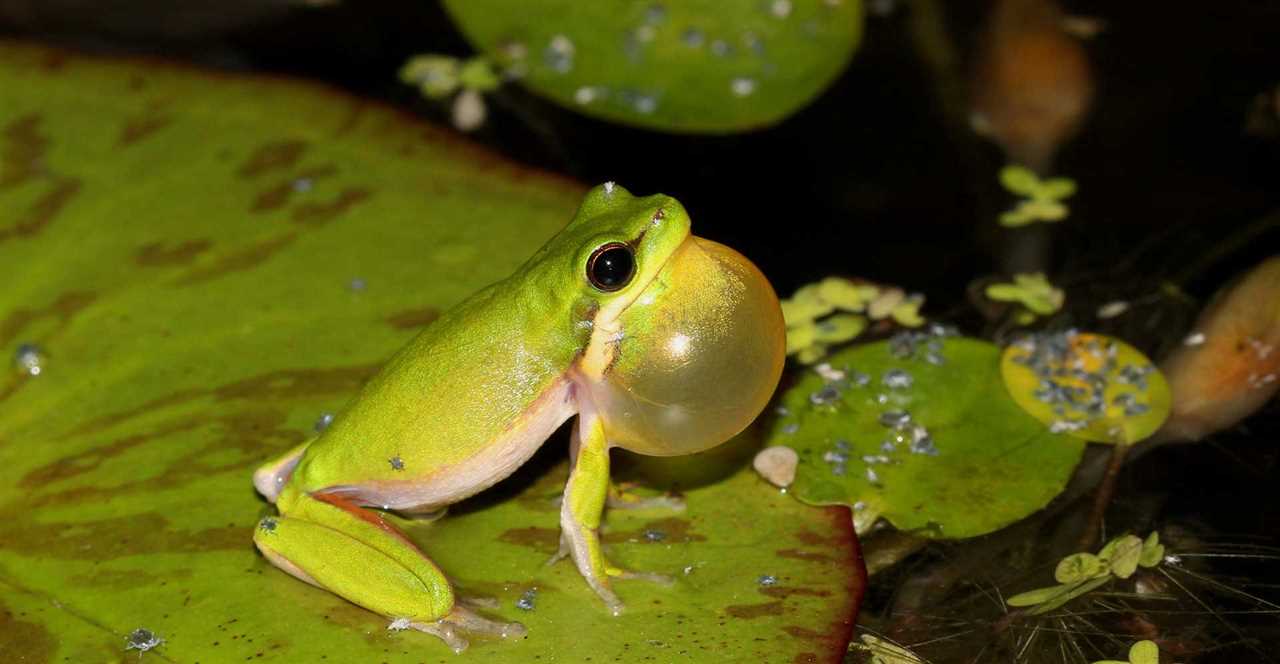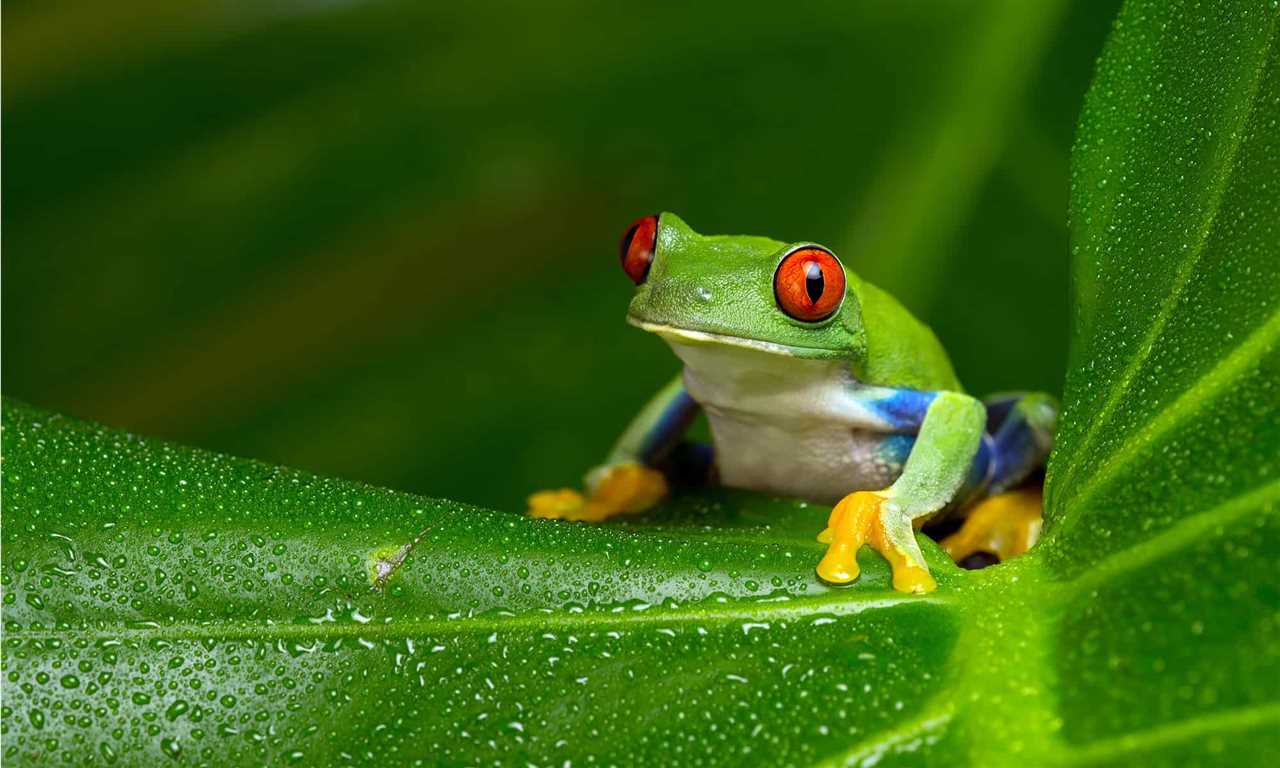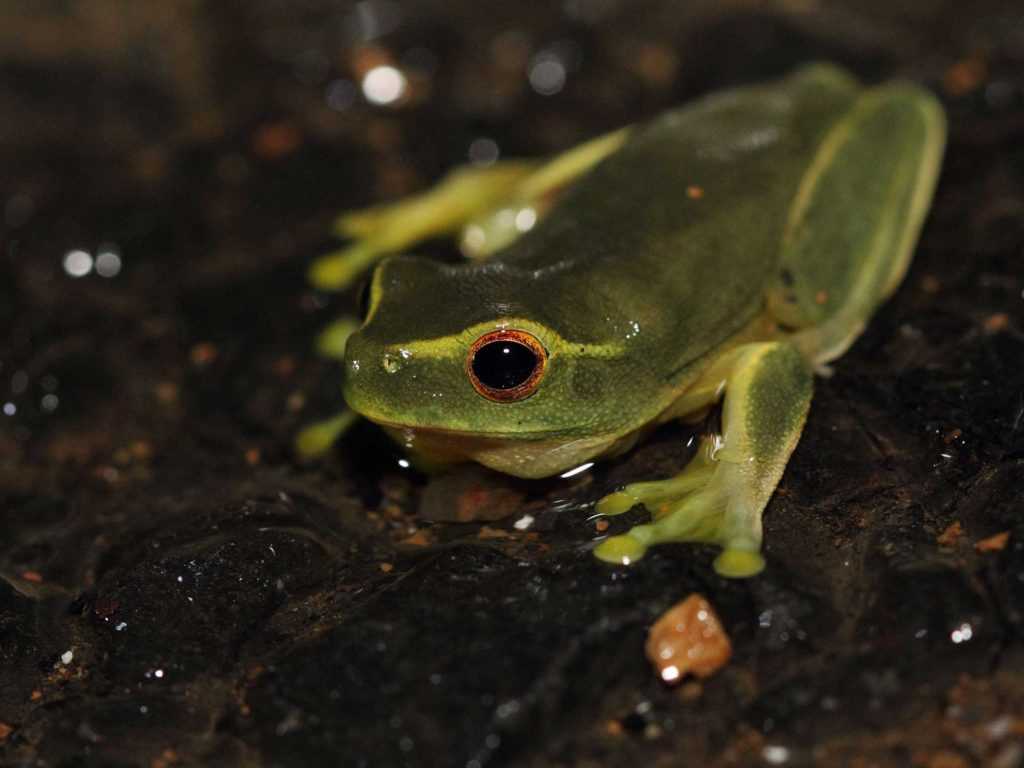
Well, the answer is yes and no. Unlike some other animals that hibernate for the entire winter season, tree frogs have a different approach. Instead of going into a deep sleep, they enter a state of dormancy. During this time, their metabolic rate slows down, and their activity levels decrease significantly.
While they may not fully hibernate like some other animals, tree frogs are still able to survive the colder months. They do this by seeking out sheltered areas, such as tree hollows or under piles of leaves, where they can stay protected from the harsh weather conditions. This is a natural strategy that helps them conserve energy and survive until the warmer months arrive.
Different Types of Tree Frogs

Tree frogs are a diverse group of amphibians that belong to the family Hylidae. There are numerous species of tree frogs found all over the world, including North and South America, Europe, Africa, and Australia. These fascinating creatures possess unique characteristics that allow them to thrive in various habitats, such as rainforests, tropical forests, and even deserts.
Colorful and Camouflaged
One remarkable feature of tree frogs is their vibrant and diverse coloration. Many species exhibit bright hues of green, yellow, blue, or red, which serve as a form of camouflage, helping them blend in with their surroundings. These colors often change depending on the temperature, light, and their mood. Some tree frogs also have patterns or markings that further aid in their camouflage, making it difficult for predators to spot them.
Arboreal Adaptations
Tree frogs are well-adapted for life in trees. They have specially adapted toes with sticky pads or disks that allow them to easily cling to different surfaces. This unique adaptation enables them to move effortlessly in their arboreal habitat, scaling trees and even hanging upside down. The structure of their feet also varies among different species, with some having longer toes for grasping branches and others having webbed feet for swimming.
These amphibians also have large, forward-facing eyes that provide them with excellent vision, enabling them to accurately judge distances and locate prey. Additionally, their eyes have a transparent layer called a nictitating membrane, which protects their sensitive eyes while allowing them to see even when their eyes are closed.
Various Tree Frog Species
Some well-known species of tree frogs include the Red-eyed Tree Frog, famous for its striking red eyes and vibrant green body; the White’s Tree Frog, known for its plump and warty appearance; the European Tree Frog, with its distinctive green coloration and varying patterns; and the Gray Tree Frog, known for its excellent camouflage abilities and ability to change colors.
Hibernation Behavior of Tree Frogs
Tree frogs, like many other cold-blooded animals, do hibernate. Hibernation is a physiological state of inactivity that allows these frogs to survive during periods of low temperatures, limited food resources, and unfavorable environmental conditions.
During hibernation, tree frogs enter a state of dormancy, where their metabolic processes slow down significantly. They reduce their activity levels, heart rate, and breathing rate to conserve energy. This helps them survive in habitats where food availability is scarce during the winter months.
Trigger for Hibernation
Hibernation Locations
Tree frogs choose hibernation locations that provide insulation and protection from extreme temperatures. They often select spots such as tree cavities, rock crevices, or underground burrows. These locations offer them shelter from freezing temperatures, drying winds, and predators.
Behavioral Adaptations
During hibernation, tree frogs undergo several behavioral adaptations to survive the harsh conditions. They become dormant and reduce their movement and metabolic processes. Their body temperature drops to match the surrounding environment, and their breathing becomes shallow. This enables them to conserve energy and survive on stored fat reserves.
Health Considerations
Hibernation plays a crucial role in the overall health and survival of tree frogs. It allows them to conserve energy and escape unfavorable conditions during the winter months. Proper hibernation is essential for their physiological well-being, immune system function, and reproductive success.
| Benefits of Hibernation for Tree Frogs: | Challenges of Hibernation for Tree Frogs: |
|---|---|
| – Energy conservation | – Limited food availability |
| – Protection from extreme temperatures | – Risk of predation |
| – Maintaining physiological health | – Potential for dehydration |
Environmental Factors Affecting Hibernation

Moisture levels also play a significant role in tree frog hibernation. Excessive moisture can be detrimental to their survival, as it can lead to the growth of harmful fungi and bacteria. On the other hand, insufficient moisture can cause dehydration and physiological stress.
Additionally, the availability of suitable hiding spots is essential for tree frog hibernation. These frogs need secure, well-insulated locations where they can remain undisturbed throughout the winter. They often seek out natural crevices, leaf litter, or burrows to provide the necessary protection from predators and harsh weather conditions.
Human activities and habitat destruction can disrupt these environmental factors and negatively impact tree frog hibernation. Deforestation, pollution, and climate change can alter the temperature and moisture levels of their habitats, making it challenging for them to find suitable locations for hibernation. Conservation efforts are crucial in preserving the habitats of tree frogs and ensuring their survival.
Physiological Changes During Hibernation in Tree Frogs

Hibernation is a fascinating phenomenon observed in various animal species, including tree frogs. During hibernation, tree frogs undergo several physiological changes that enable them to survive in a dormant state for extended periods of time.
Another notable physiological change during hibernation is the formation of cryoprotectants in the tree frog’s body. Cryoprotectants are substances that protect cells and tissues from freezing damage. Tree frogs produce specialized proteins and other compounds that act as cryoprotectants, preventing the formation of ice crystals within their bodies and protecting vital organs and tissues.
During hibernation, tree frogs also experience a decrease in respiration and heart rate. This reduction in physiological processes helps them conserve energy and withstand the harsh conditions of winter. They enter a state of deep sleep, where they remain inactive and unresponsive to external stimuli.
Preparing for Hibernation: What Do Tree Frogs Need to Survive?
1. Finding a Safe Location: Tree frogs are masters of disguise and can camouflage themselves within their environment. During the preparation stage, they begin searching for a safe location to hibernate. This can include tree cavities, leaf litter, or underground burrows. The chosen location should provide protection from predators and extreme weather conditions.
4. Feeding and Fat Storage: Before entering hibernation, tree frogs need to ensure they have enough fat reserves to sustain them throughout the winter. They will actively feed and consume as much food as possible to build up their fat stores. These fat reserves serve as a vital energy source during hibernation when food sources are scarce.
5. Metabolic Adaptations: As tree frogs prepare for hibernation, their metabolic rate decreases significantly. This metabolic adaptation allows them to conserve energy and put their bodily functions on hold during hibernation. Their heart rate, breathing rate, and other physiological processes slow down, enabling them to survive with minimal energy requirements.
6. Avoiding Frostbite: Though tree frogs are cold-blooded, they still need to avoid frostbite during hibernation. To protect themselves, they seek out hibernation sites that are below the frost line. This ensures that their bodies remain at a safe temperature, preventing them from freezing and suffering tissue damage.
By following these preparations, tree frogs increase their chances of surviving the harsh winter months. Hibernation is a critical period in their life cycle, and without proper preparation, they may not survive to see another spring.
Duration of Hibernation
One of the fascinating aspects of tree frogs is their ability to hibernate for extended periods of time. The duration of hibernation varies depending on various factors, including the species of tree frog and the environmental conditions.
Tree frogs typically enter hibernation during the colder months when temperatures drop and food becomes scarce. During this time, they seek out safe and protected places to spend the winter months. These can include crevices in rocks, underground burrows, or even in the mud at the bottom of ponds.
The length of hibernation can range from a few weeks to several months. Different tree frog species have different hibernation periods, with some entering hibernation as early as October and emerging in the spring, while others may hibernate for as long as six months.
During hibernation, tree frogs undergo significant physiological changes. Their metabolism slows down, and their heart rate and breathing rate decrease dramatically. Their body temperature also drops to match the temperature of their surroundings. These adaptations allow them to conserve energy and survive with minimal resources during the dormant period.
The Effects of Hibernation on Tree Frogs
One of the most noticeable effects of hibernation on tree frogs is their change in coloration. Many tree frog species have the ability to change their skin color to blend in with their surroundings. During hibernation, their skin often becomes paler or even white, which helps them camouflage with the snow or frost-covered environment.
Another effect of hibernation is the preservation of body mass and muscle strength. Tree frogs rely on stored energy reserves, such as fats and glycogen, to sustain themselves during hibernation. This allows them to maintain their muscle tone and overall body condition, even when they are not actively foraging for food.
Additionally, hibernation plays a crucial role in the reproductive cycle of tree frogs. By entering a state of dormancy, tree frogs can synchronize their breeding activities with the onset of favorable environmental conditions. This ensures that their offspring have a higher chance of survival when they hatch or emerge after hibernation.
However, hibernation is not without its challenges for tree frogs. If the environmental conditions become too extreme or fluctuate too rapidly, it can disrupt their hibernation process, leading to detrimental effects on their health and survival. It is essential to protect their hibernation habitats and maintain stable environmental conditions to ensure the well-being of these fascinating creatures.
Signs of Exiting Hibernation
Do frogs hibernate? The answer is yes, many species of tree frogs do hibernate during the winter months. Hibernation is a survival strategy for these cold-blooded amphibians to conserve energy and protect themselves from harsh environmental conditions.
When winter comes to an end and temperatures start to rise, tree frogs begin to show signs of exiting hibernation. These signs can vary depending on the species and their specific hibernation habits.
Tree frogs may also start to explore their surroundings and look for suitable breeding sites. They may return to their previous habitats or migrate to new locations with more favorable conditions. This movement is essential for their survival and successful reproduction.
Overall, the signs of exiting hibernation in tree frogs include increased activity, brighter coloration, exploring their surroundings, and resuming feeding. These signs indicate that the frogs have successfully survived the winter and are ready to take on the challenges of the warmer months ahead.
Importance of Hibernation for Tree Frog Survival
Hibernation is a crucial aspect of a tree frog’s life cycle and plays a vital role in their survival. During the cold winter months, when food becomes scarce and temperatures drop, tree frogs enter a state of hibernation to conserve energy and protect themselves from harsh conditions.
Preserving Energy
Hibernation allows tree frogs to conserve energy by reducing their metabolic rate. During this period, their heart rate decreases significantly, and their breathing becomes slower. This adaptation helps them cope with the limited resources available during winter and enables them to survive for extended periods without nourishment.
Protection from Extreme Temperatures

Tree frogs are ectothermic, meaning that their body temperature is dependent on their environment. Hibernation helps them escape the cold temperatures that would otherwise be detrimental to their well-being. By finding shelter in burrows, leaf litter, or logs, tree frogs can shield themselves from freezing temperatures, frost, and other harsh weather conditions.
Conservation of Water
Preventing Predation
Hibernation also acts as a defense mechanism against predators. By becoming inactive and immobile, tree frogs are less likely to attract the attention of predators. Their reduced metabolic rate and slowed vital functions make them less detectable and vulnerable to potential threats.
Regulation of Hormones
Hibernation is not only crucial for survival during winter but also for reproductive success in the following breeding season. It helps regulate the production and release of hormones necessary for reproduction. The period of hibernation enables tree frogs to synchronize their reproductive cycles, ensuring optimal timing for mating and spawning.
Conservation Efforts for Tree Frogs and Hibernation
Hibernation is a crucial period in the life cycle of tree frogs, and the conservation efforts for these amphibians play a vital role in their survival. Due to various environmental factors and human activities, the habitats of tree frogs are rapidly declining, putting their populations at risk. Therefore, it is essential to implement measures to protect their hibernation sites and ensure the long-term survival of these unique creatures.
Conservation efforts for tree frogs focus on creating and maintaining suitable hibernation habitats. This includes preserving and restoring natural habitats such as wetlands, forests, and meadows that provide the necessary conditions for tree frogs to hibernate. Additionally, artificial hibernation sites, such as specially designed hibernacula or underground chambers, can be created to supplement and enhance the availability of suitable hibernation spots.
| Conservation Measures | Description |
|---|---|
| Land Protection | Efforts are made to protect and conserve the land where tree frogs hibernate, ensuring their habitats remain intact and free from disturbances such as urban development or habitat fragmentation. |
| Restoration | Restorative measures, like reforestation and wetland restoration, help create or improve hibernation habitats that might have been degraded or destroyed due to human activities. |
| Educational Programs | Education initiatives play a crucial role in raising awareness about the importance of tree frogs and hibernation. These programs educate the public about the ecological significance of protecting hibernation habitats and how to minimize human impact. |
| Monitoring and Research | Regular monitoring and research are conducted to understand the population dynamics of tree frogs and their hibernation behavior. This information helps guide conservation efforts and develop strategies to protect their hibernation sites. |
| Captive Breeding Programs | In situations where tree frog populations are severely threatened or endangered, captive breeding programs are implemented to ensure the survival and genetic diversity of these species. These programs aim to reintroduce tree frogs into their natural habitats when conditions improve. |
The conservation efforts for tree frogs and their hibernation are crucial for maintaining the balance of ecosystems they inhabit. By protecting hibernation sites and implementing measures to minimize human impact, we can ensure the survival of these fascinating creatures for future generations to enjoy. It is our responsibility to preserve the natural world and all the unique species that call it home.

I’m Lena Adams—a product of an unconventional upbringing in the African wilderness. My father, a daring explorer of African wildlife, sparked my fascination with reptiles, a passion that intertwined with the tragic loss of my mother during an expedition, leaving an indelible mark on my life. Driven to understand the creatures that captivated my parents, I embarked on my journey, sharing insights about reptiles, frogs, and lizards on my website. Through my explorations and conservation efforts, I honour my family’s legacy while seeking connections—to the creatures, nature, and the mother whose presence I yearn to understand.
